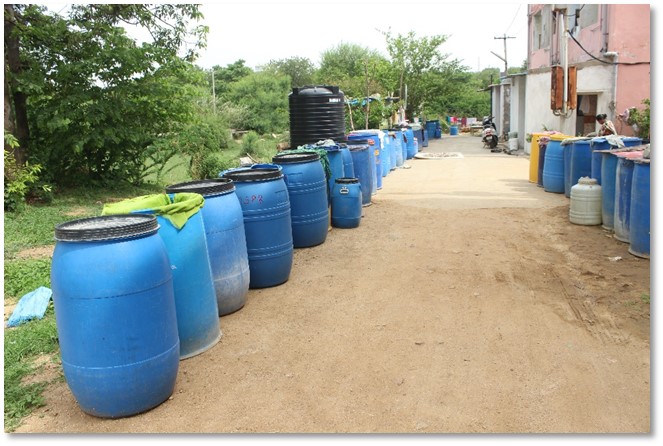
Questioning Informality
Every study village of the project “Ensuring Water Security in Metropolitan Hyderabad” has a different story and situation — bringing to light the various aspects of the informal water market. However, the answer to the most pertinent question still remains partially answered –‘Are informal water tankers good or bad?’ In order to be able to attach a value to this market, we need to understand the role of every stakeholder involved.
This informal market has two dominant sides: the buyers and sellers. The villages that are selling water are examples of transfer of resources from peri-urban to urban sites, depriving the peri-urban dwellers of their right to these resources. Some of the water sellers used to be agriculturalists, selling water from the land they used to practice farming on. Some of them still make use of the subsidized electricity they were provided for agriculture. Those who own land have assumed the ownership to the resource below it- the water table, and have begun selling it for profit. Those who have access to this natural resource have power over those who do not, and this manifests into economic power through the profits that this business reaps for them. This economic power makes sure that their influence on the use and access to water increases or at least remains the same. The fewer the sellers, the more is their control on the resource, and the more skewed is the pattern of usage of this water. Thus this cycle of exploitation of the resource continues, with the larger population depending on a handful of people.
Moreover, in these seller villages, the villagers have to pay for a resource that actually belongs to them. In Kokapet, one of the study village for the project, most of the water from the village is sold outside to industrial and commercial zones. Since the villagers are competing with outsiders(urban dwellers) for the same resource the pricing becomes such that it is less affordable for the villagers. This brings about the question of justice, as the ‘have-nots’ are being made to compete with the ‘haves’ for a resource that they should be able to access at a minimal rate. The tanker market is unregulated, and hence there is no control on the rate of extraction of water. This, added to sporadic rainfall over the past few years has added to groundwater depletion and resulted in a fallen water table. In villages like Mallampet, people have complained about not being able to extract water even at 800 feet.
But then there is the other side of the market, the buyers. In another study village, Malkaram, the tankers come as a sort of respite in a situation of bleak hope. In the entire village, just a handful of houses have panchayat water connections and fewer have been able to afford to dig borewells. There is one community stand post for river-water, and few other community borewell pumps. But in the summer months, none of these sources are enough. The village has to depend on water from tankers. None of them can afford full tankers, so they just fill two drums for Rs.100- Rs.130. But this source is an absolute necessity for these people, to carry on their daily lives. These informal tankers cover at least some portion of the gap between demand and supply.
Despite the externalities that the tanker market poses, the fact that it sometimes is the only source of water for people in desperate need of water, should force stakeholders and policymakers to look at it as more than just a legal or illegal market. The market is undoubtedly in need of regulation for the rate of extraction of water, the prices charged for water and the direction of flow of this water. Although currently not in its best form, it can potentially be used as an effective tool in bridging the gaps of the formal water supply network. The government should make efforts to integrate this market with their water supply system, rather than eliminating it.

LEAVE A COMMENT